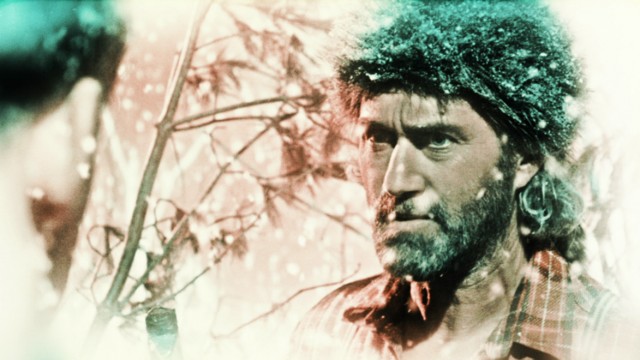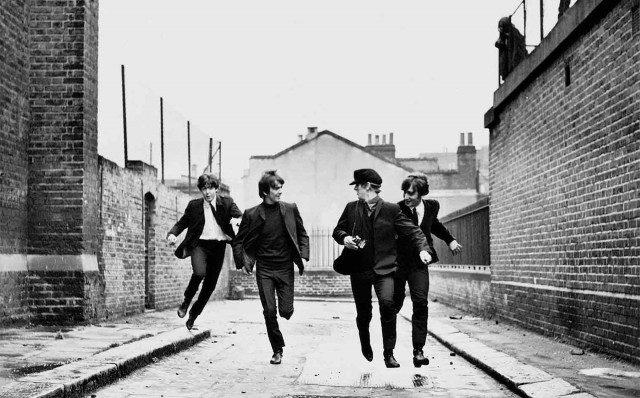
The Fab Four are on the run in A HARD DAY’S NIGHT, screening at Lincoln Center as part of Richard Lester retrospective
A HARD DAY’S NIGHT (Richard Lester, 1964)
Film Society of Lincoln Center, Walter Reade Theater
165 West 65th St. between Eighth Ave. & Broadway
Saturday, August 8, 1:00
Festival runs August 7-13
212-875-5050
www.filmlinc.org
www.thebeatles.com
 The Beatles are invading America again with the fiftieth anniversary restoration of their debut film, the deliriously funny anarchic comedy A Hard Day’s Night. Initially released on July 6, 1964, in the UK, AHDN turned out to be much more than just a promotional piece advertising the Fab Four and their music. Instead, it quickly became a huge critical and popular success, a highly influential work that presaged Monty Python and MTV while also honoring the Marx Brothers, Buster Keaton, Jacques Tati, and the French New Wave. Directed by Richard Lester, who had previously made the eleven-minute The Running Jumping & Standing Still Film with Peter Sellers and would go on to make A Funny Thing Happened on the Way to the Forum, Petulia, and The Three Musketeers, the madcap romp opens with the first chord of the title track as John Lennon, Paul McCartney, George Harrison, and Ringo Starr are running down a narrow street, being chased by rabid fans, but they’re coming toward the camera, welcoming viewers into their crazy world. (George’s fall was unscripted but left in the scene.) As the song blasts over the soundtrack, Lester introduces the major characters: the four moptops, who are clearly having a ball, led by John’s infectious smile, in addition to Paul’s “very clean” grandfather (Wilfrid Brambell, who played a dirty old man in the British series Steptoe and Son, the inspiration for Sanford and Son) and the band’s much-put-upon manager, Norm (Norman Rossington). Lester and cinematographer Gilbert Taylor (Dr. Strangelove or: How I Learned to Stop Worrying and Love the Bomb, Repulsion, Star Wars) also establish the pace and look of the film, a frantic black-and-white frolic shot in a cinema-vérité style that is like a mockumentary taking off from where François Truffaut’s 400 Blows ends. The boys eventually make it onto a train, which is taking them back to their hometown of Liverpool, where they are scheduled to appear on a television show helmed by a hapless director (Victor Spinetti, who would star in Help as well) who essentially represents all those people who are dubious about the Beatles and the sea change going on in the music industry. Norm and road manager Shake (John Junkin) have the virtually impossible task of ensuring that John, Paul, George, and Ringo make it to the show on time, but there is no containing the energetic enthusiasm and contagious curiosity the quartet has for experiencing everything their success has to offer — while also sticking their tongues out at class structure, societal trends, and the culture of celebrity itself.
The Beatles are invading America again with the fiftieth anniversary restoration of their debut film, the deliriously funny anarchic comedy A Hard Day’s Night. Initially released on July 6, 1964, in the UK, AHDN turned out to be much more than just a promotional piece advertising the Fab Four and their music. Instead, it quickly became a huge critical and popular success, a highly influential work that presaged Monty Python and MTV while also honoring the Marx Brothers, Buster Keaton, Jacques Tati, and the French New Wave. Directed by Richard Lester, who had previously made the eleven-minute The Running Jumping & Standing Still Film with Peter Sellers and would go on to make A Funny Thing Happened on the Way to the Forum, Petulia, and The Three Musketeers, the madcap romp opens with the first chord of the title track as John Lennon, Paul McCartney, George Harrison, and Ringo Starr are running down a narrow street, being chased by rabid fans, but they’re coming toward the camera, welcoming viewers into their crazy world. (George’s fall was unscripted but left in the scene.) As the song blasts over the soundtrack, Lester introduces the major characters: the four moptops, who are clearly having a ball, led by John’s infectious smile, in addition to Paul’s “very clean” grandfather (Wilfrid Brambell, who played a dirty old man in the British series Steptoe and Son, the inspiration for Sanford and Son) and the band’s much-put-upon manager, Norm (Norman Rossington). Lester and cinematographer Gilbert Taylor (Dr. Strangelove or: How I Learned to Stop Worrying and Love the Bomb, Repulsion, Star Wars) also establish the pace and look of the film, a frantic black-and-white frolic shot in a cinema-vérité style that is like a mockumentary taking off from where François Truffaut’s 400 Blows ends. The boys eventually make it onto a train, which is taking them back to their hometown of Liverpool, where they are scheduled to appear on a television show helmed by a hapless director (Victor Spinetti, who would star in Help as well) who essentially represents all those people who are dubious about the Beatles and the sea change going on in the music industry. Norm and road manager Shake (John Junkin) have the virtually impossible task of ensuring that John, Paul, George, and Ringo make it to the show on time, but there is no containing the energetic enthusiasm and contagious curiosity the quartet has for experiencing everything their success has to offer — while also sticking their tongues out at class structure, societal trends, and the culture of celebrity itself.
Lester and Oscar-nominated screenwriter Alun Owen develop each individual Beatle’s unique character through press interviews, solo sojourns (the underappreciated Ringo goes off on a kind of vision quest; George is mistaken by a fashion fop for a model), and an endless stream of spoken and visual one-liners. (John sniffs a Coke bottle; a reporter asks George, “What do you call your hairstyle?” to which the Quiet One replies, “Arthur.”) Oh, the music is rather good too, featuring such songs as “I Should Have Known Better,” “All My Loving,” “If I Fell,” “Can’t Buy Me Love,” “I’m Happy Just to Dance with You,” “This Boy,” and “She Loves You.” The working name for the film was Beatlemania, but it was eventually changed to A Hard Day’s Night, based on a Ringo malapropism, forcing John and Paul to quickly write the title track. No mere exploitation flick, A Hard Day’s Night is one of the funniest, most influential films ever made, capturing a critical moment in pop-culture history and unleashing four extraordinary gentlemen on an unsuspecting world. Don’t you dare miss this glorious eighty-five-minute explosion of sheer, unadulterated joy. The restoration, courtesy of Janus Films, is screening August 8 at the Walter Reade Theater as part of the Film Society of Lincoln Center tribute series “Richard Lester: The Running Jumping Pop Cinema Iconoclast” and will be preceded by The Running Jumping & Standing Still Film. The festival runs August 7-13 and consists of most of the now-eighty-three-year-old Philadelphia native’s films, including Robin and Marian, The Bed Sitting Room, Juggernaut, Cuba, The Royal Flash, and the above-mentioned titles. “Growing up, I always thought of Richard Lester as one of the 1960s’ most typically English filmmakers — not just because of his irreverent and absurd sense of humor and his feel for English life but also for the affectionate way he sent up familiar icons from the Beatles to the Three Musketeers to even Superman,” Film Comment editor and FSLC senior programmer Gavin Smith said in reference to the series. “Imagine my surprise when I first learned he was actually an expat Yank. Regardless, he’s still a great English filmmaker!”
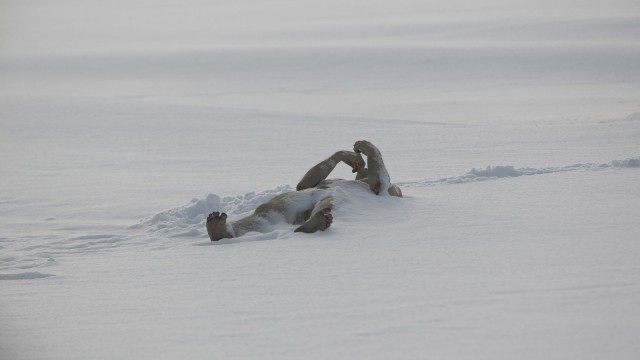
 In Alaska, a company called North is preparing to drill for oil in the Arctic National Wildlife Refuge, with the permission of the U.S. government. North has sent along environmentalist James Hoffman (James LeGros) and his assistant, Elliot Taylor (Jamie Harrold), to ensure that the team, led by the imposing Ed Pollack (Ron Perlman), follows all proper guidelines and agreements. But when strange things start happening — including weird visions, odd disappearances, and brutal deaths — Pollack is determined to move forward, no matter the cost. Written and directed by Larry Fessenden (Habit, Wendigo), who also makes a cameo in the film, The Last Winter is a global-warming horror story in the tradition of John Carpenter’s The Thing, where the small cast of characters never knows just what is waiting for them around every corner — and out on the treacherous, blindingly white landscape that surrounds and engulfs them. The film also stars Connie Britton (Friday Night Lights) as Abby Sellers, a strong-minded woman who has left Pollack for Hoffman; indie stalwart Kevin Corrigan (Walking and Talking) as vehicle expert Motor; Zach Gilford (Friday Night Lights) as young and innocent Maxwell McKinder; Grammy-winning composer and musician Joanne Shenandoah (Skywoman) as Dawn Russell, who prepares the meals and cleans up after everyone; and Pato Hoffmann (Dr. Quinn, Medicine Woman) as Lee Means, a Native American who has a deep understanding of the land and the spirits. A scary look at an all-too-possible future, The Last Winter is screening on November 3 at 7:00 in the Film Society of Lincoln Center series “Scary Movies 9,” appropriately enough, and will be followed by a Q&A with Fessenden, Perlman, and LeGros. “An Evening with Larry Fessenden,” who is celebrating the thirtieth anniversary of his indie film company, Glass Eye Pix, continues at 9:30 with Mickey Keating’s Darling, followed by a Q&A with Keating, Fessenden, and actors Lauren Ashley Carter and Brian Morvant.
In Alaska, a company called North is preparing to drill for oil in the Arctic National Wildlife Refuge, with the permission of the U.S. government. North has sent along environmentalist James Hoffman (James LeGros) and his assistant, Elliot Taylor (Jamie Harrold), to ensure that the team, led by the imposing Ed Pollack (Ron Perlman), follows all proper guidelines and agreements. But when strange things start happening — including weird visions, odd disappearances, and brutal deaths — Pollack is determined to move forward, no matter the cost. Written and directed by Larry Fessenden (Habit, Wendigo), who also makes a cameo in the film, The Last Winter is a global-warming horror story in the tradition of John Carpenter’s The Thing, where the small cast of characters never knows just what is waiting for them around every corner — and out on the treacherous, blindingly white landscape that surrounds and engulfs them. The film also stars Connie Britton (Friday Night Lights) as Abby Sellers, a strong-minded woman who has left Pollack for Hoffman; indie stalwart Kevin Corrigan (Walking and Talking) as vehicle expert Motor; Zach Gilford (Friday Night Lights) as young and innocent Maxwell McKinder; Grammy-winning composer and musician Joanne Shenandoah (Skywoman) as Dawn Russell, who prepares the meals and cleans up after everyone; and Pato Hoffmann (Dr. Quinn, Medicine Woman) as Lee Means, a Native American who has a deep understanding of the land and the spirits. A scary look at an all-too-possible future, The Last Winter is screening on November 3 at 7:00 in the Film Society of Lincoln Center series “Scary Movies 9,” appropriately enough, and will be followed by a Q&A with Fessenden, Perlman, and LeGros. “An Evening with Larry Fessenden,” who is celebrating the thirtieth anniversary of his indie film company, Glass Eye Pix, continues at 9:30 with Mickey Keating’s Darling, followed by a Q&A with Keating, Fessenden, and actors Lauren Ashley Carter and Brian Morvant.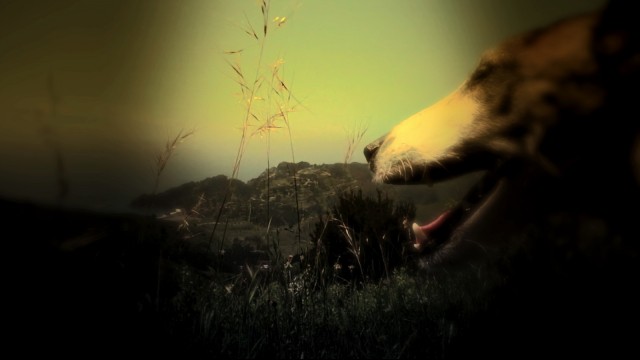

 Rebecca Miller channels her inner Woody Allen and Noah Baumbach with the bittersweet romantic comedy Maggie’s Plan, making its U.S. premiere at the fifty-third New York Film Festival. Greta Gerwig is at her loopy best as Maggie, a thirtysomething college arts administrator who, after failing to maintain any relationship for more than six months, decides to become a single mother by impregnating herself with the sperm of an old classmate, Guy (Travis Fimmel), a Brooklyn hipster trying to become a pickle mogul. (He works for the real Brooklyn Brine Co.) Maggie’s married best buds, former boyfriend Tony (Bill Hader) and Felicia (Maya Rudolph), who have just had a baby themselves, debate her decision, but she is determined to forge ahead. As she prepares for the artificial insemination, which she is performing herself, she grows close with older New School adjunct professor John (Ethan Hawke), a ficto-crypto-anthropologist working on his novel. John has two kids of his own but is feeling overwhelmed by his wife, Georgette (Julianne Moore), a wickedly ambitious educator who has just been offered a lofty position at Columbia. Soon Maggie, John, and Georgette are in the midst of a complicated love triangle that is at times as frustrating to watch as it is endearing.
Rebecca Miller channels her inner Woody Allen and Noah Baumbach with the bittersweet romantic comedy Maggie’s Plan, making its U.S. premiere at the fifty-third New York Film Festival. Greta Gerwig is at her loopy best as Maggie, a thirtysomething college arts administrator who, after failing to maintain any relationship for more than six months, decides to become a single mother by impregnating herself with the sperm of an old classmate, Guy (Travis Fimmel), a Brooklyn hipster trying to become a pickle mogul. (He works for the real Brooklyn Brine Co.) Maggie’s married best buds, former boyfriend Tony (Bill Hader) and Felicia (Maya Rudolph), who have just had a baby themselves, debate her decision, but she is determined to forge ahead. As she prepares for the artificial insemination, which she is performing herself, she grows close with older New School adjunct professor John (Ethan Hawke), a ficto-crypto-anthropologist working on his novel. John has two kids of his own but is feeling overwhelmed by his wife, Georgette (Julianne Moore), a wickedly ambitious educator who has just been offered a lofty position at Columbia. Soon Maggie, John, and Georgette are in the midst of a complicated love triangle that is at times as frustrating to watch as it is endearing. 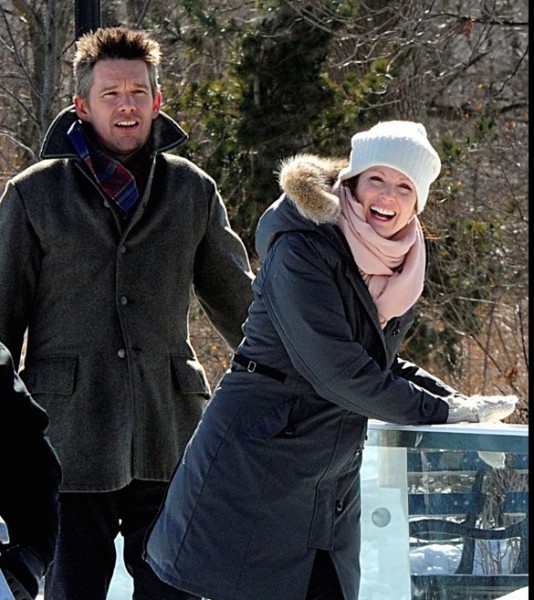
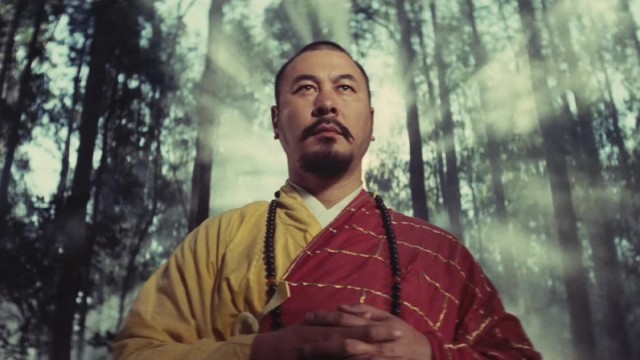
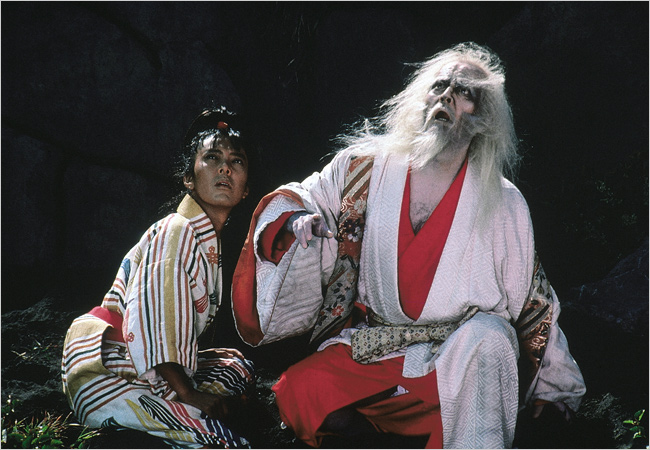
 Inspired by the story of feudal lord Mori Motonari and Shakespeare’s King Lear, Akira Kurosawa’s Ran is an epic masterpiece about the decline and fall of the Ichimonji clan. Aging Lord Hidetora (Tatsuya Nakadai) is ready to hand over his land and leadership to his three sons, Taro (Akira Terao), Jiro (Jinpachi Nezu), and Saburo (Daisuke Ryû). But jealousy, misunderstandings, and outright deceit and treachery result in Saburo’s banishment and a violent power struggle between the weak eldest, Taro, and the warrior Jiro. Hidetaro soon finds himself rejected by his children and wandering the vast, empty landscape with his wise, sarcastic fool, Kyoami (Peter), as the once-proud king descends into madness. Dressed in white robes and with wild white hair, Nakadai (
Inspired by the story of feudal lord Mori Motonari and Shakespeare’s King Lear, Akira Kurosawa’s Ran is an epic masterpiece about the decline and fall of the Ichimonji clan. Aging Lord Hidetora (Tatsuya Nakadai) is ready to hand over his land and leadership to his three sons, Taro (Akira Terao), Jiro (Jinpachi Nezu), and Saburo (Daisuke Ryû). But jealousy, misunderstandings, and outright deceit and treachery result in Saburo’s banishment and a violent power struggle between the weak eldest, Taro, and the warrior Jiro. Hidetaro soon finds himself rejected by his children and wandering the vast, empty landscape with his wise, sarcastic fool, Kyoami (Peter), as the once-proud king descends into madness. Dressed in white robes and with wild white hair, Nakadai (